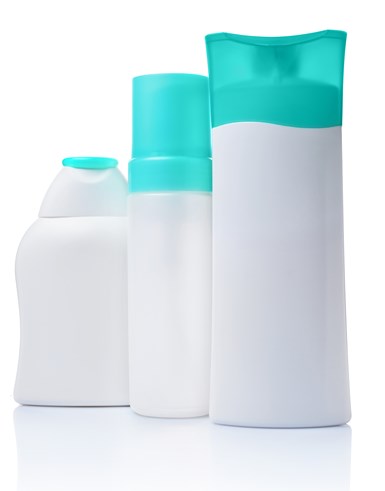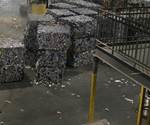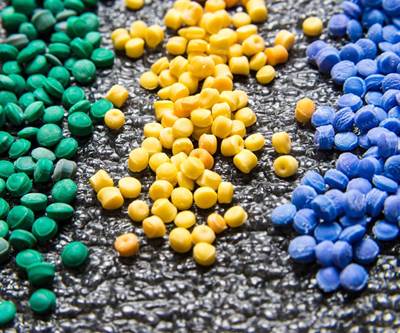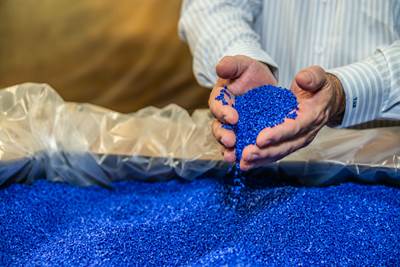
Highly-loaded color concentrates have been proving their mettle in terms of cost-performance in rigid packaging and building products.
As younger engineers and buyers enter the plastics industry, there is a need to provide the next generation with the right fundamental knowledge and awareness to produce high-quality colored plastic parts. Designers and brand owners understand the importance of choosing the right color to ensure their products stand out from the competition. Yet they often may not have enough fundamental knowledge and awareness to produce quality colored plastic parts, and turn to their processing partners for help. With a focus on highly loaded color pellet concentrates, here is a guide for processors of rigid packaging and building products on how to specify the colorant, along with examples of how processors in these markets are using new color technologies to give their products a boost. Most of the principles discussed here generally apply to other end-use markets as well.
Processing Basics & Technology Options
Choosing colors for your products is a critical part of the development cycle. Designers and processors looking for ideas or trends can use sources such as Color Marketing Group, Pantone, paint companies, magazines, and social media.
Once you get some general ideas, the most effective way to complete this part of the process is to work directly with a color concentrate supply partner. They can mold color chips, bottles, or other sample parts in your resin that capture your vision of the end product.
One of the most important factors to keep in mind when designing a plastic product is that both the resin and color concentrate must be suitable for the intended process, such as injection, blow, compression molding or extrusion. This is because resins, pigments, dyes, and additives must be able to withstand extreme heat exposure during the molding process, including shear heat generated when a material flows into a mold. If the material on its own is not sufficiently durable for its end-use environment, it will likely need additives that screen out UV rays, antioxidants, or other stabilizers to protect against polymer degradation that can lead both to discoloration and product failure.
The next decision is to choose your colorant technology. The two most widely available choices are precolor and masterbatches in either liquid or pellet form. Both liquid and standard pellet options have their benefits and challenges. It is best to investigate both in depth to determine what would work best for your operations. Ideally, a winning program requires a colorant format that provides maximal benefit with minimal challenges.
Both liquid and standard pellet options have their benefits and challenges.
Precolor is easier to use since the color is already fully incorporated into the resin process. However, precolor costs more to produce and often requires keeping considerable inventory on hand, as compounders generally have minimum order requirements. Even with good forecasting, there is always a threat that the product might reach the end of its sales cycle before your precolor supply is depleted.
Masterbatches minimize your color inventory. Even so, there are choices to be be made. For example, conventional pelletized color masterbatches are typically more costly than liquid colorants due to the latter’s high letdown ratios.
Today, with recent advances in dosing equipment and availability of new technology for highly loaded pellet concentrates, processors can reduce cost and production challenges. The latest pellet feeding systems can dose highly loaded pellets at levels down to 1.0% and below.
Color-concentrate pellets can be strand cut (cylindrical) or underwater cut (round). In general, the pellets are smaller than those of the customer’s resin. For special needs, concentrates can be provided as mini-pellets.
For the most part, highly loaded color concentrates use carrier technology similar to that of conventional color concentrates. That is, typically the carrier resin is generically the same as the customer’s resin—e.g., a PE carrier is used for coloring a PE part. However, the concentrate pellets commonly have a higher melt flow than the customer’s base resin to ensure the color is readily distributed throughout the part during processing.
Coloring Polyolefin and PET Packaging
In the packaging world, there is no one-size-fits-all solution for a particular type of container. It all depends on the intended contents and use. Both HDPE and PP have proven to be good options for a variety of rigid packaging applications.
HDPE is one of the most common resins for rigid packaging because it is very durable. It also maintains its stiff shape during filling and is resistant to abrasion and punctures. Yet, compared with clear PS, PET, and PVC, HDPE can look a little gray on the shelf next to clear containers. This is why most HDPE packages are colored.
Moreover, colored HDPE packaging generally has better stress-crack and chemical resistance, which is especially important for applications such as household cleaners and detergents that require more durability and a longer shelf life. HDPE is also resistant to warpage, distortion and UV light.
Polypropylene is also used in a variety of packaging applications because it is tough and heat resistant up to 180 F. One of the popular uses for PP is living hinges on bottles for ketchup, sour cream, and water.
Many PP living-hinge applications require nucleating agents such as silica, talc and organic salts to accelerate the crystallization rate to help reduce injection molding cycle times, thus lowering production costs. A reputable color pellet concentrate supplier will know the right choice of pigment and nucleating agents to capture production efficiencies without compromising living-hinge performance.
Both virgin and recycled PET are used heavily for a variety of packaging beverages, food, and consumer products. Color concentrates for these resins have been around for years. Until recently, conventional pellet concentrate based on a PET carrier had not been cost-effective for coloring PET because loadings were low compared with liquid color, and the concentrated had to be dried. Recently a new polymeric carrier technology was introduced (Chroma’s UltraPET). This carrier not only has excellent compatibility with PET polymers used in packaging but also offers the following benefits:
▪ Mini beads provide more pellets per gram with a larger surface area to improve color distribution—a feature especially useful for tint colors.
▪ They process at a much lower temperature than conventional PET concentrates, reducing the heat stress on the pigments and dyes.
▪ They offer exceptionally high loading of both pigments and dyes, and consequently, economical letdown ratios. In most cases, the extremely low use rate eliminates the need for drying and recrystallization, unlike conventional PET pellet concentrates.
Targeted applications for this new PET product line include cosmetic packaging, vitamin bottles, nutraceuticals, sample liquor bottles, spice jars, and thermoformed sheets.
Coloring Recycled Materials
There is much talk and growing action among consumer brands regarding use of more recycled materials in their packaging. Many brand owners are focusing on meeting goals for packaging made with post-consumer recycled (PCR) content, particularly PET and polyolefins, by 2025 or a little later.
Many processors are facing the challenge of finding reprocessed PCR resins designed to meet the specific application requirement.
If you are serious about making the switch to recycled resins, select a color company with success in providing color and additive concentrates that include processing aids, impact modifiers and UV and other stabilizers, as additives besides color may be required to bring PCR up to spec. Today, some suppliers even offer 100% PCR-based color and additive concentrates that allow brand owners to claim that the product is 100% PCR.
As the demand for coloring recycled PE and PP packaging continues to grow you are going to need a colorant supplier you can count on for the right colorant package, as lots of the recycling stream is colored yellow or grey. and the only way to produce a package with great color using rPET is with highly-loaded color concentrates.
Coloring Building & Construction Products
Every year there is an increase in the diversity and number of plastic products used in the building and construction industry. The broad range of plastic building products in this market includes cables, conduit, pipe, cladding, windows, doors, protective and decorative shutters, architectural roof tiles, decking, siding and flooring. Although these products perform well, adding color delivers the aesthetics desired by the brand or consumer, identifies them for specific usage (color-coding), and in many cases, defines the application. You may be familiar with the fact that plastic pipe and conduit are color-coded by their end-use application, such as:
▪ Blue = Potable Water
▪ White = Irrigation and Water
▪ Green = Sewer
▪ Purple (Lavender) = Reclaimed Water
▪ Gray = Electrical Conduit
▪ Orange = Telecommunication, conduit
▪ Yellow = Natural Gas (methane or propane) oil
▪ Red = Electric Power Lines, Lighting Cable
Once again, the biggest challenge related to coloring plastic building products is accurately matching the desired color in the specific product resin. Typical plastic resin types used in construction include PE, PP, TPO, PVC, PC, ASA, ABS, POM, nylon, acrylic, and a variety of thermoplastic composites.
It is critical to establish a partnership with your color and additives supplier early in the development process to achieve specific color and performance attributes. After determining the correct resin, your conversation may move to color selection. Typically, your supplier will have color sample chips or Pantone color charts to pinpoint the desired color for each plastic product or part.
During this selection process, colors may look different depending on gloss, grain, filler, resin type, light sources, and other factors. For example, in high UV light environments, colors such as red, orange, and yellow typically fade faster than darker colors such as blue or green.
Sidebar
Highly Loaded Concentrates Give
Building, Packaging Processors the Edge
Processors in the building/construction and packaging markets have gained an edge from switching to highly loaded pellet concentrates such as Chroma Color’s G2 and G3 products. Here are some specifics:
▪ Radiant Pipe: G2 provided one processor a cost-effective solution for a high-temperature coextruded pipe used in radiant heating. A vibrant color was used for the ultra-thin outer skin layer of PE-RT (raised temperature) HDPE and a standard solid for the PE-RT HDPE inner layer against the copper pipe core, thereby reducing the overall colorant cost.
The G2 concentrate was used here at 0.75%. Despite used at a lower level than for conventional concentrates, the highly loaded G2 pellets delivered a sufficiently high concentration of UV stabilizers and absorbers used to prevent fading and polymer degradation. The pipe is now available in red, blue and white.

G2 provided a cost-effective solution for a pipe used in radiant heating with only the ultra-thin outer layer—coextruded PCR-HDPE, colored in a vibrant red.
▪ TPO Roof Membrane: Chroma formulated a G2 product package that offered UV and antioxidant stabilization at half the usage rate of the existing product in the market for a processor extruding lightweight TPO roof membranes. Typical concentrates in this market are used at 12-15%, whereas the G2 concentrate is used at 6%. The lower use level ended up substantially slashing overall price per pound, and also resulted in reduced inventory requirements to free up floor space and cash.
 A Chroma G2 color concentrate with UV and antioxidant stabilization formulated at half the usage rate of the existing products did the job for a manufacturer of lightweight TPO roofing membranes
A Chroma G2 color concentrate with UV and antioxidant stabilization formulated at half the usage rate of the existing products did the job for a manufacturer of lightweight TPO roofing membranesOn the packaging side, developing products to meet customers' demands can be challenging as the major brands have exacting color requirements. Restrictive cost pressures compound the difficulty of consistently meeting brand retail shelf expectations.
▪ Teal (Turquoise) HDPE Lids The particular teal color-space is critical to this brand's identification in a cosmetics product line. Yet, it faced multiple color-related concerns, such as part-to-part inconsistency, which forced the processor to consume the existing colorant at substantially higher use rates to achieve visual color uniformity. These higher use rates forced production inefficiencies, significantly higher than desired colorant inventories, and elevated levels of finished component inventory to ensure required lead times were maintained.

Chroma’s G3 highly loaded concentrate provided superior dispersion, eliminating color variations in the sensitive teal color space for a cosmetics line.
Consequently, the brand’s packaging team and processor jointly began searching for an alternative colorant to resolve the multiple challenges of color stability, processing difficulties, excessive use rates, and overall package cost. During their investigations, we introduced the patented G-series colorant technologies. The G-series technology includes both G2 and G3 formulations. Molding trials were conducted with both technologies to identify the most appropriate and beneficial package.
The solution proved to be the G3 system which provided superior color dispersion, eliminating color variation. It also reduced the use rate from 4% to 1.5% letdown, lowering the overall coloring cost. Moreover, it provided faster cycle times, more cost-effective color changeovers with less purging, and reduced downtime.
The lower letdowns , along with the processing benefits of the G-series, allowed the molder to meet the required production demands. Further, the lower color requirements, coupled with the improved production efficiencies, provided desperately needed warehouse storage space. The numerous benefits brought to the program by this technology eventually led to a complete switch on all colorants for this brand's needs.
▪ HDPE Blow Molded Bottle: Chroma participated in a trial with one very large blow molder in the packaging industry. The company had been impressed with their current suppliers’ letdown ratio; however, after talking with Chroma, agreed to test out the new G3 product line.
The previous supplier’s color concentrate had a recommended letdown of 2.5%. Chroma submitted two samples of G3 concentrates at 1.5%, and 1.7% letdowns. During the blow molding trial, the 1.5% sample achieved the color specification at a 1.14% average usage. In comparison, the competitive concentrate's average usage rate was 5.96%, as determined by post-trial thermogravimetric analysis (TGA) testing. The TGA testing also confirmed that G3 concentrate contained 65% pigment versus 26% in the incumbent’s conventional concentrate—2.5 times more pigment per pellet.
 TGA testing confirmed that the HDPE blow molded bottle with G3 concentrate contained 2.5 times more pigment per pellet than the incumbent concentrate.
TGA testing confirmed that the HDPE blow molded bottle with G3 concentrate contained 2.5 times more pigment per pellet than the incumbent concentrate.Equally important, no changes to the blow molder's processing parameters were required to run the Chroma concentrate, eliminating any additional challenges for the manufacturing team.
ABOUT THE AUTHORS: Dr. Ron Harris has been a technology development consultant to Chroma Color Corp. and its legacy company Carolina Color for 14 years. For the past 39 years he has been involved in several aspects of coloring plastics, from making pigments and polymeric materials to formulating custom colors. He holds 16 patents in the fields of plastics materials, laser marking, and plastics coloration and decoration. Contact: 704-637-7000; rharris@chromacolors.com; chromacolors.com.
Hari Rajaraman has over 33 years of industrial experience with polymers. He has been a consultant for the past 21 years in the areas of color concentrates, polymer additives, plastics processing and landscape coatings. Hari’s full time work experience includes six years with a leading manufacturer of nylon resins and fibers in India and six years with M.A. Hanna in the U.S. He has been granted 6 U.S. patents and has three patent applications pending . Contact: hrajaraman@chromacolors.com.
Related Content
At NPE2024, Follow These Megatrends in Materials and Additives
Offerings range from recycled, biobased, biodegradable and monomaterial structures that enhance recyclability to additives that are more efficient, sustainable and safer to use.
Read MoreLatest Data on Bottled Water Shows Continued Strong Growth
Bottled water’s volume surpassed soft drinks for the first time in 2016 and has done so every year since.
Read MoreICIS Launches: Ask ICIS Generative AI Commodities Assistant
Said to be the first of its kind, this AI assistant will enhance access to ICIS’ intelligence and insights for the energy and chemical markets.
Read MoreEvolving Opportunities for Ambitious Plastics Recycler
St. Joseph Plastics grew from a simple grinding operation and now pursues growing markets in recycled PP, food-grade recycled materials, and customized post-industrial and post-consumer compounds.
Read MoreRead Next
Chroma Color Acquires Plastics Color Corp.
Chroma has further expanded its colorant and additives business with its newest acquisition of Plastics Color.
Read MoreMeet the New Force in Color Concentrate Production
The new Chroma Color Corp. unites the production and technical expertise of four different firms to better serve the needs of a consolidating processor market.
Read MoreFour Packaging Trends to Consider for 2020
Chroma Color’s Bishop Beall discusses his views on key trends to consider in the development of plastic packaging going forward.
Read More






























